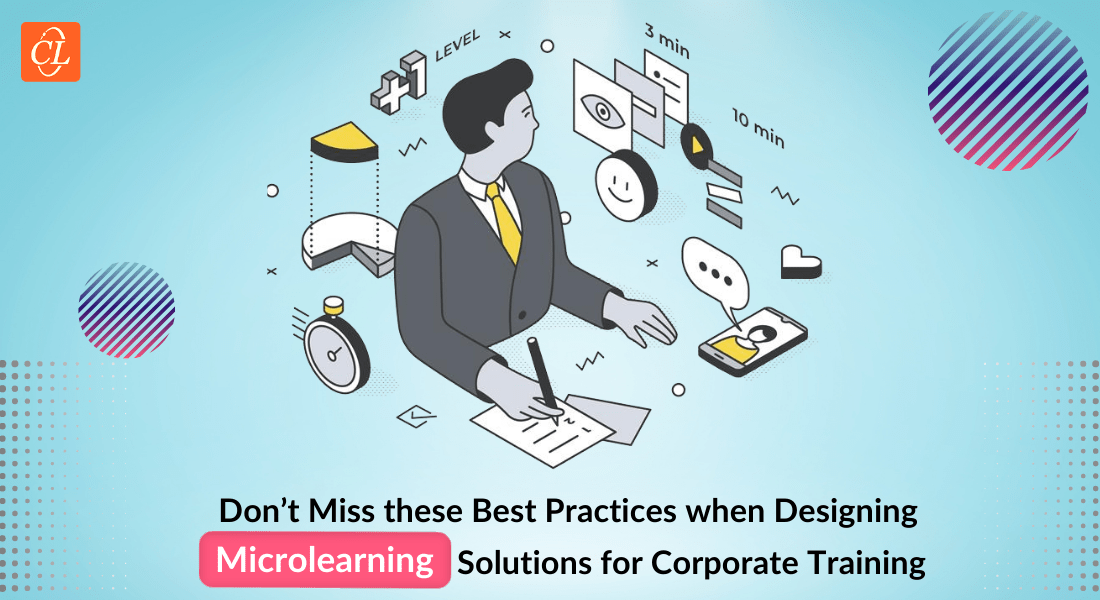5 Killer Microlearning Examples for Corporate Training

The increase in the availability of smartphones and the internet has played a catalyst in the increased adoption of digital learning. But it doesn’t stop there, learners today are opting for shorter, easy-to-consume content. This brings them to microlearning.
Microlearning content is short and focused in nature. This makes it the best choice for digital learners, especially corporate employees, who have to juggle between their work and learning to upgrade their skills. The very nature of microlearning fulfills their need for eLearning materials that offer easy accessibility and device compatibility, and availability whenever needed.
Microlearning Can Make Corporate Training More Impactful
Let’s see how it can be used for:
- Sales Training
- Health and Safety Training
- Employee Onboarding
- Product Training
- Technology Training
But how exactly can microlearning be used for corporate training? Let us discuss:
Microlearning Examples for Corporate Training
1. Sales Training
Customers are supreme for a business and it is very important for the teams, especially the customer-facing ones, to be well-versed as to how to talk to customers. Customer-facing teams, especially the sales teams, should know how to communicate with the customer, and understand what works better. All this is done through sales training, and microlearning adds new efficiencies to sales training, especially who are mostly on-field and find it difficult to spend long hours learning something new.
L&D managers can send sales training courses, operational guides, and other corporate learning materials to the employees, wherever they are, instantly.
Microlearning Example for Sales Training
Microlearning assets such as short videos serve as an excellent way to deliver sales training. These can include text, audio as well as visual content as well as animations. This way, it is possible to address both auditory as well as visual parts of learners’ minds. They can be more engaging and can be consumed on the go. Infographics, simulation-based courses and use of animations can also be used to make the sales training more impactful.
Microlearning – The Mega Advantage to Your On-the-Move Sales Team
2. Health and Safety Training
Health and safety training is extremely important, especially for manufacturing companies. However, owing to the complexity of the training, it is difficult to keep the learners engaged. This can be addressed using microlearning – different modalities can be used to deliver the content in an engaging way to retain the learners’ interests.
Microlearning Example for Health and Safety Training
Understanding Health and Safety training is not just complex but the topics can also be dry, and this could lead to learner disengagement. One way to solve this problem is by increasing their involvement with the content delivered. Here is the logic – when the learners are involved, they make more efforts to understand the subject.
Considering this, puzzles, quizzes, and even game-based learning activities can be used to deliver Health and Safety training. This will increase their engagement and also keep them motivated to complete the course.
3. Employee Onboarding
Orienting new employees is not a one-time task. It takes the employees at least a few months to understand and remember the HR policies and initiatives. Microlearning can be an ideal solution to familiarize new hires with company policies and HR initiatives. As microlearning content is short and available at the time of need, it suffices the learning preferences of Millennial and Gen Z dominant workforce. Additionally, hosting microlearning courses of learning delivery on a Learning Management System (LMS), helps HR teams and learning managers track employee progress.
Microlearning Example for Employee Onboarding
Microlearning assets like game-based learning, infographics, or even short videos can be a great way to onboard employees. Apart from giving them an impressive welcome, this type of onboarding can also boost their morale. Learning managers can use different microlearning assets to communicate company regulations, processes, emergency procedures, and much more.
4. Product Training
Multinational companies with their operations spread across the world are tasked to train multiple teams on their updated and/or new products. This can be challenging as the teams are spread across the world and it is difficult to bring all the team members together to train them. Language and time zones can be a major barrier when doing so, and delivering learning via the traditional eLearning approach can prove to be impractical. The use of the microlearning approach can serve as a more practical eLearning solution. Microlearning lessons are mobile, simple, and easy to understand.
Microlearning Example for Product Training
Different formats of microlearning can be used to deliver product training. Short, ‘how to’ videos can be a great way to train employees on the product. Similarly, you can be using infographics, and flashcards to convey product features, benefits or use cases. The only thing that has to be kept in mind is to keep the content simple and very specific.
5. Technology Training
Technology adoption has become a mandate for businesses today. However, not all employees are proficient with technology. Additionally, technology keeps updating. So, the employees need to be continuously trained to advance their technical skills. Microlearning relies on bite-sized training modules, and it is easy to make microlearning content accessible for any device. So larger technology training modules, which are otherwise difficult to keep up with, can be redesigned so the employees can consume them easily.
Microlearning Example for Technology Training
Animations serve as a very effective way to illustrate or explain concepts that are otherwise difficult to understand. Microlearning developers can come up with several short and simple animations to explain complex concepts revolving around technology. For instance, an animation can be used to explain “the new features of a new technology” or “how the new technology has a positive impact on their work”. Interactive, simulation-based courses may also be a great option to deliver technical training.
Summing it up
Microlearning serves as a concrete way to deliver corporate eLearning. Microlearning assets like infographics, short videos, games, make it easy to explain even the most complex of topics. This makes the lives of trainers’ easy. On the other hand, the anywhere-anytime availability of microlearning content makes it a preferred choice for Gen Z and Millennial workforce. If you are still in doubt on how to use it, the examples discussed above can help you draw inspiration and help you decide the best way to implement microlearning.
But if you are still wondering how a small learning byte of 5-10 minutes work wonders for your employee training and help meet organizational goals, you need to grab this eBook.



![4 Ways to Create Microlearning for your Sales Training [Infographic]](https://blog.commlabindia.com/hubfs/Imported_Blog_Media/microlearning-for-sales-training-infographic.png)

![How to Create Quick Microlearning Courses using Rapid eLearning [Infographic]](https://blog.commlabindia.com/hubfs/Imported_Blog_Media/microlearning-development-rapid-elearning-info.jpg)